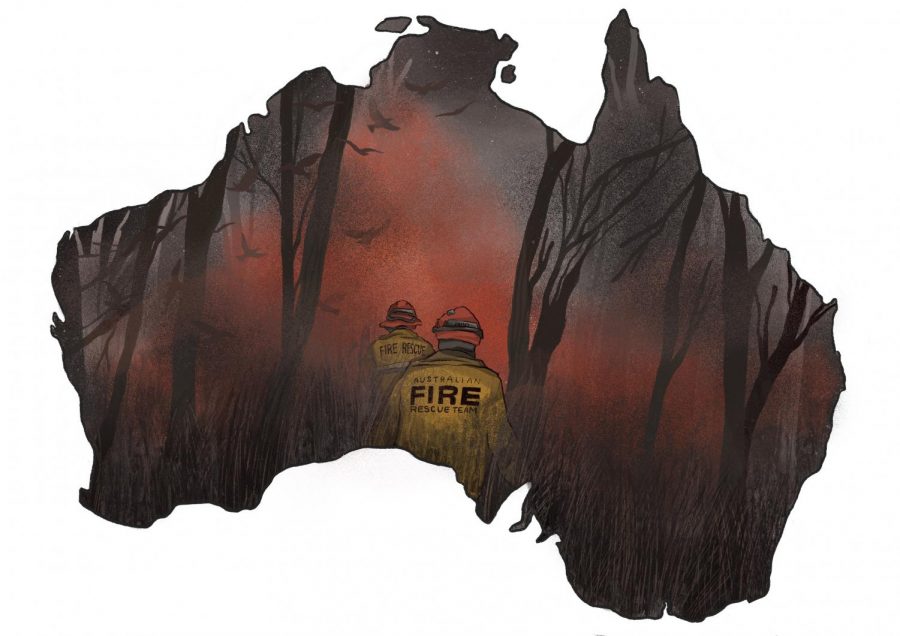Bushfires devastate Australian wildlife
February 7, 2020
Australia has been engulfed in numerous wildfires since the fire season began in late July. As of Jan. 13, 28 casualties and over 2,000 destroyed homes have been recorded. While there are several speculated causes for the fires, the main source has been attributed to an intense drought that spread out over the course of a year, eventually culminating in the annual Australian bushfires.
This year, however, the fires have been much more aggressive, tearing through the heart of the country and destroying several forms of natural life. On Jan. 2, New South Wales declared a state of emergency for the third time, with the previous two occurring in November and January and each lasting for seven days. Scientists have placed the blame on climate change, claiming that it can make “such extreme deadly blazes three times as common by the end of the century,” according to marine geochemist Carolyn Gramling.
Australia has experienced a grueling season of records this past year: its second hottest year ever recorded (107.4 degrees Fahrenheit), its driest spring and some of the highest fire danger warnings ever measured on the Forest Fire Danger Index. These extreme weather conditions made it easier for fire to catch and burn forests at an alarming rate.
Lightning sparks and climate abnormalities also inflamed moisture-free grass on the Australian flood bed. Once the fires ignited, the high winds carried the flames far, creating a “mega-flame” like the one formed on the border of New South Wales and Victoria.
According to The Guardian, the merging of these fires has resulted in large-scale evacuation orders and over $1 billion in property damages. To aid in relief, individual citizens as well as companies and organizations have pledged various sums of money. Australian celebrities Chris Hemsworth, Margot Robbie and Nicole Kidman are among those who have donated to help rebuild communities affected by the ravaging fires.
Celebrities aren’t the only ones attempting to help Australia. Amidst the chaos of the fires in January, American firefighters landed in Australia under voluntary assignment. According to an article by CNN’s David Williams, Australia and New Zealand have sent their firefighters to the United States for over 15 years, but the last time U.S. firefighters were present on duty in Australia was in 2010.
In a turn of events, a recent string of rain showers in the country have assisted the firefighters. But it appears as though the relief of rain is a “double-edged sword.”
“The storms have ushered in a host of new problems, like flooding, while exacerbating old ones; lightning strikes have sparked at least two new fires in the Great Otway National Park,” Time Magazine’s Melissa Godin said.
Overall, the fires have taken a large toll on Australia’s unique flora and fauna. The magnitude of the wildlife destruction can be seen clearly through satellite images of Kangaroo Island, a famous tourist destination and wildlife sanctuary. BBC’s Shaimaa Khalil describes the once-beautiful landscape as now just rows of blackened trees and charred animal bodies.
“You cannot escape the death and destruction,” Khalil described.
Overall, governmental attempts to solve the problems have been bleak. Prime Minister Scott Morrison’s response to climate change and the ongoing fires has angered individuals worldwide. According to The New Yorker’s Carolyn Kormann, Morrison ignored meeting requests from former firefighters who were intending to warn him of the need for more water bombers.
“In December, despite the increasing intensity and speed at which many bushfires were spreading, he took a holiday to Hawaii, only prompted to return early after the death of two volunteer firemen. During his first day back in the office, he told a Sydney radio station that he was still considering new coal-fired power plants,” Kormann said.
Morrison’s attitude toward the climate crisis served as the exigent moment for protests across Australia. Individuals demonstrated against the negligence of the government and demanded action from authorities.
“Friday’s protests pushed for five main demands: funding for firefighters, relief and aid for affected communities, land and water sovereignty for indigenous communities, an immediate transition toward renewable energy and a just transition for workers in the fossil fuel industry,” CNN’s Helen Regan and Jessie Yeung said.
At present, there seems to be no permanent relief for the affected areas in Australia. There exists potential risk for the fires to escalate and further damage the landscape.



